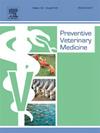Estimation of the risk of cohabitation with Johne's disease-infected cattle in Japanese dairy cows
IF 2.2
2区 农林科学
Q1 VETERINARY SCIENCES
引用次数: 0
Abstract
Johne's disease is a chronic granulomatous enteritis of cattle caused by Mycobacterium avium subsp. paratuberculosis. It is one of the most important diseases in the cattle farming industry in Japan, as no effective treatment or vaccine is available. Because oral ingestion of Mycobacterium avium subsp. paratuberculosis from the feces of infected cattle is the primary route of transmission, cohabitation with infected cattle is an obvious risk factor for Johne's disease infection. This study aimed to quantify the risk of Johne's disease infection in dairy cattle due to cohabitation with infected cattle using data from the national Johne's disease surveillance and a complete set of movement histories of the relevant cattle. We also estimated the effect of cattle age on the risk of cohabitation. The relative risk of cohabitation with Johne's disease-infected cattle was 82, indicating that cohabitation with infected cattle was a significant risk factor for Johne's disease infection. When the risk of cattle cohabiting with Johne's disease-infected cattle at less than one year of age was estimated, the relative risk increased to 138, suggesting that the isolation of susceptible young cattle from potentially infected cattle is an effective preventive measure. When the relative risk was calculated for cattle cohabiting with Johne's disease-infected cattle younger than the cut-off age (two to seven years of age), the relative risk increased at a higher cut-off age, suggesting that restricting cohabitation with older cattle is more effective in mitigating Johne's disease infection.
日本奶牛与感染约翰氏病的牛同居的风险评估
约翰氏病是一种由鸟分枝杆菌引起的牛慢性肉芽肿性肠炎。副结核。这是日本养牛业中最重要的疾病之一,因为没有有效的治疗方法或疫苗。因为口服鸟分枝杆菌亚种。来自病牛粪便的副结核病是主要传播途径,与病牛同居是感染约翰氏病的明显危险因素。本研究旨在利用来自全国约翰氏病监测的数据和相关牛的一整套运动历史,量化奶牛与感染约翰氏病的牛同居的风险。我们还估计了牛龄对同居风险的影响。与感染约翰氏病的牛同居的相对危险度为82,表明与感染约翰氏病的牛同居是感染约翰氏病的重要危险因素。当估计一岁以下的牛与感染约翰氏病的牛同居的风险时,相对风险增加到138,这表明将易感的小牛与潜在感染的牛隔离是一种有效的预防措施。当计算与小于截止年龄(2 - 7岁)的感染约翰氏病的牛同居的相对风险时,相对风险随着截止年龄的增加而增加,这表明限制与年龄较大的牛同居在减轻约翰氏病感染方面更有效。
本文章由计算机程序翻译,如有差异,请以英文原文为准。
求助全文
约1分钟内获得全文
求助全文
来源期刊

Preventive veterinary medicine
农林科学-兽医学
CiteScore
5.60
自引率
7.70%
发文量
184
审稿时长
3 months
期刊介绍:
Preventive Veterinary Medicine is one of the leading international resources for scientific reports on animal health programs and preventive veterinary medicine. The journal follows the guidelines for standardizing and strengthening the reporting of biomedical research which are available from the CONSORT, MOOSE, PRISMA, REFLECT, STARD, and STROBE statements. The journal focuses on:
Epidemiology of health events relevant to domestic and wild animals;
Economic impacts of epidemic and endemic animal and zoonotic diseases;
Latest methods and approaches in veterinary epidemiology;
Disease and infection control or eradication measures;
The "One Health" concept and the relationships between veterinary medicine, human health, animal-production systems, and the environment;
Development of new techniques in surveillance systems and diagnosis;
Evaluation and control of diseases in animal populations.
 求助内容:
求助内容: 应助结果提醒方式:
应助结果提醒方式:


